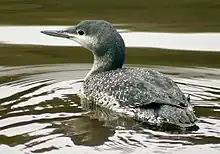Phaethoquornithes
Phaethoquornithes is a clade of birds that contains Eurypygimorphae and Aequornithes,[4] which was first recovered by genome analysis in 2014.[5] Members of Eurypygimorphae were originally classified in the obsolete group Metaves, and Aequornithes were classified as the sister taxon to Musophagiformes or Gruiformes.[6][7]
| Phaethoquornithes | |
|---|---|
 | |
| Juvenile red-throated loon (Gavia stellata) | |
| Scientific classification | |
| Domain: | Eukaryota |
| Kingdom: | Animalia |
| Phylum: | Chordata |
| Clade: | Dinosauria |
| Class: | Aves |
| Clade: | Passerea |
| Clade: | Phaethoquornithes Sangster et al., 2022[3] |
| Subgroups | |
| Synonyms | |
|
Ardeae | |
This group has also been informally called Ardeae.[8] Older classifications have used Ardeae in a different sense, as a suborder of Ciconiiformes containing herons and related species.[9]
| Phaethoquornithes |
| ||||||||||||||||||||||||||||||||||||||||||
Cladogram based on Kuhl et al. (2020),[2] with clade names following Sangster et al (2022).[4]
References
- Slack, Kerryn E.; Jones, Craig M.; Ando, Tatsuro; Harrison, G.L. "Abby"; Fordyce, R. Ewan; Arnason, Ulfur; Penny, David (2006). "Early Penguin Fossils, plus Mitochondrial Genomes, Calibrate Avian Evolution". Molecular Biology and Evolution. 23 (#6): 1144–1155. CiteSeerX 10.1.1.113.4549. doi:10.1093/molbev/msj124. PMID 16533822. Supplementary Material Archived December 16, 2009, at the Wayback Machine
- Kuhl., H.; Frankl-Vilches, C.; Bakker, A.; Mayr, G.; Nikolaus, G.; Boerno, S. T.; Klages, S.; Timmermann, B.; Gahr, M. (2020). "An unbiased molecular approach using 3'UTRs resolves the avian family-level tree of life". Molecular Biology and Evolution. 38: 108–127. doi:10.1093/molbev/msaa191. PMC 7783168. PMID 32781465.
- Sangster, G.; Braun, E.L.; Johansson, U.S.; Kimball, R.T.; Mayr, G.; Suh, A. (2022). "Phylogenetic definitions for 25 higher-level clade names of birds". Avian Research. 13: 100027. doi:10.1016/j.avrs.2022.100027.
- Sangster, George; Braun, Edward L.; Johansson, Ulf S.; Kimball, Rebecca T.; Mayr, Gerald; Suh, Alexander (2022). "Phylogenetic definitions for 25 higher-level clade names of birds". Avian Research. 13: 100027. doi:10.1016/j.avrs.2022.100027. S2CID 247988800.
- Jarvis, E.D.; et al. (12 December 2014). "Whole-genome analyses resolve early branches in the tree of life of modern birds". Science. 346 (6215): 1320–1331. Bibcode:2014Sci...346.1320J. doi:10.1126/science.1253451. PMC 4405904. PMID 25504713.
- Ericson, P. G.P; Anderson, C. L; Britton, T.; Elzanowski, A.; Johansson, U. S; Kallersjo, M.; Ohlson, J. I; Parsons, T. J; Zuccon, D.; Mayr, G. (22 December 2006). "Diversification of Neoaves: integration of molecular sequence data and fossils". Biology Letters. 2 (4): 543–547. doi:10.1098/rsbl.2006.0523. PMC 1834003. PMID 17148284.
- Hackett, S. J.; Kimball, R. T.; Reddy, S.; et al. (27 June 2008). "A Phylogenomic Study of Birds Reveals Their Evolutionary History" (PDF). Science. 320 (5884): 1763–1768. Bibcode:2008Sci...320.1763H. doi:10.1126/science.1157704. PMID 18583609. S2CID 6472805.
- "TiF Checklist: Ardeae: Eurypygimorphae & Aequornithes".
- Wetmore, Alexander (1960). "A classification for the birds of the world". Smithsonian Miscellaneous Collections. 139 (11): 1–37. hdl:10088/22963.
